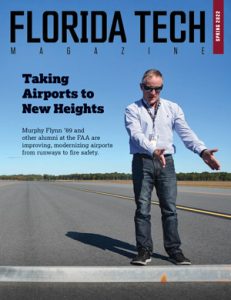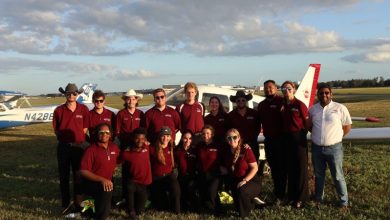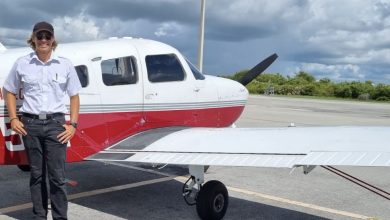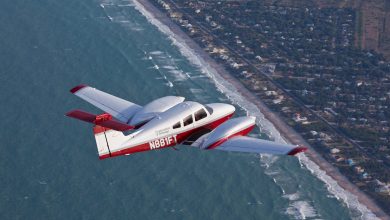Panthers at the FAA Bring Innovation and Planning to an Airport Near You
Eight Florida Tech grads are clustered in two critical areas of the federal agency, where they use research and analysis to make the nation’s airports better and safer.
Those blinking red lights that you see on cell towers, building spires, smokestacks and other structures that reach for the heavens? They are called obstruction lights, and they are meant to alert low-flying aircraft to the looming obstruction so they can avoid it.
There is one problem: These lights used LED bulbs, which are not visible to military pilots wearing night vision goggles and pilots using heads-up displays because they don’t produce the heat signature like traditional incandescent fixtures.
They were not visible, that is, until a pair of Florida Tech alumni got involved. Jim Patterson ’93 and Mike DiPilato ’05 work at the Federal Aviation Administration’s (FAA) Airport Technology Research & Development (ATR) Branch at the William J. Hughes Technical Center in Atlantic City, New Jersey. It’s an innovation hub and testing site dedicated to the safety, capacity and efficiency of U.S. airports. Staff there conduct research that helps FAA headquarters create new guidance.
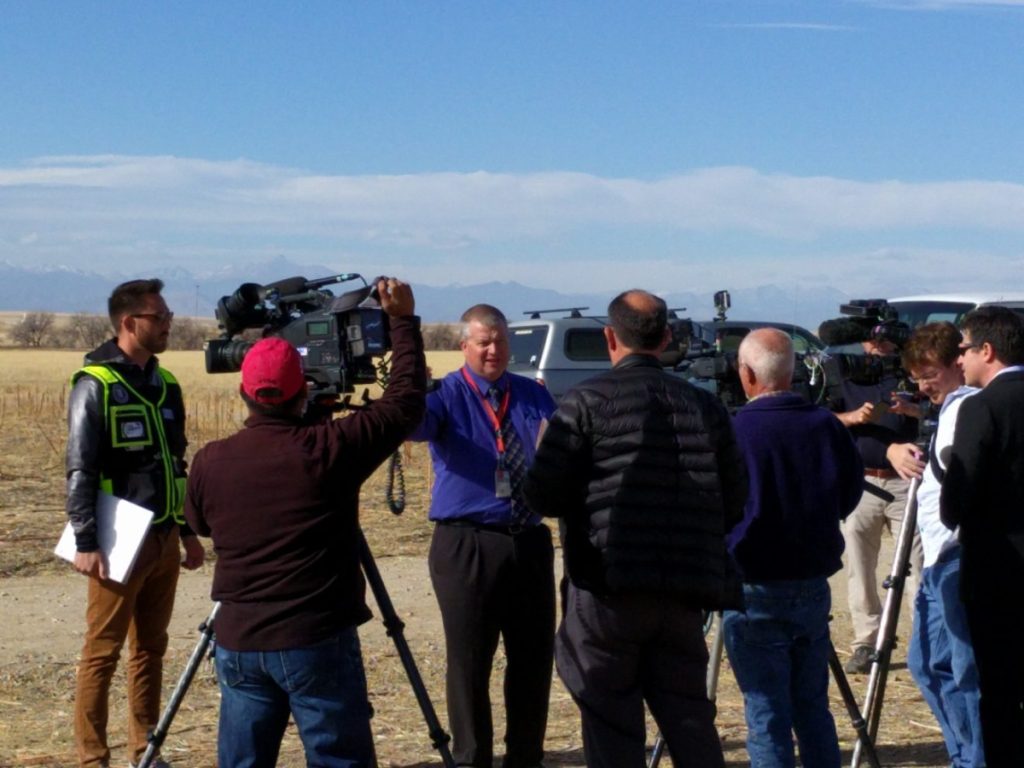
Patterson was Airport Safety Research & Development Section manager when DiPilato came aboard as an airport research specialist in 2016. One of the new guy’s first assignments was the light situation.
DiPilato and a team of FAA researchers designed a study, executed it, and developed the flight-testing program to ensure it worked.
The solution? Add a tiny infrared emitter to the LED lights, which the thermal imaging in night vision equipment can capture. This approach is now part of an FAA Advisory Circular, the document that provides official guidance to industry, institutions and others.
“That was a great accomplishment for the FAA,” DiPilato says.
Amazingly, Patterson and DiPilato are only half of the Florida Tech Panthers working in this ATR office. Murphy Flynn ’89 and Keith Bagot ’91 are there, as well.
“Florida Tech is not a very large school, particularly back in my day. But there was always that home feel to it, that tight family atmosphere,” Bagot says. “And that kind of carries over. When you see people from that same program, that same school, you have the same camaraderie.”
“We kind of have a unique bond in a sense, somewhat of a family,” DiPilato adds.
It’s a family that is improving the world around us.
Florida Tech is not a very large school, particularly back in my day. But there was always that home feel to it, that tight family atmosphere.”
Keith Bagot ’91
Take wind turbines. As tall as the Statue of Liberty, with rotor diameters that can be 500 feet or more, these increasingly ubiquitous clean-energy providers pose challenges to aviation and wildlife.
So Patterson, an expert in obstruction lighting, was asked to develop ways to increase their “conspicuity” so they can be seen, recognized, understood and avoided, all in moments. He evaluated 15 sites across the country from land and air, took feedback from pilots and determined that fewer lights, not more, is the way to go.
He tested his theory at a wind farm in Oklahoma that had 43 300-foot-tall turbines. By spacing the lights every half-mile, he was able to illuminate the farm with just 17 lights, half of what normally would have been considered. And he had them all flash in unison. This technique has been adopted into international standards now.
But he wasn’t done with turbines. Hundreds of thousands of birds die each year from striking turbines. So, Patterson is exploring painting one of the blades black to prevent the “vision blur” that causes birds to seemingly see through the blades. (Think of how you can see through a picket fence when you drive past it quickly.)
“If we do this treatment, it could make turbine blades more visible and reduce the impact to the aviation population,” he says. “If it helps birds, and aviation safety is not compromised, that’s a win for all.”
Up next: Painting one blade on each of 30 turbines at a Wyoming wind farm to see if it works.
Overall, Patterson says, “it is so cool knowing I contributed to the safety of the system.”
For the last few years, Patterson and DiPilato have been focused on another vexing challenge: drones, and how to ensure they are used effectively and safely at airports. There are five “buckets” for potential use of a drone, or unmanned aerial system (UAS), in an airport setting: obstruction analysis, wildlife hazard management, pavement inspections, aircraft rescue and firefighting, and perimeter monitoring.
DiPilato, who manages this UAS Airport Applications research program, worked with Patterson and another colleague to take it from an idea to a major research program.
“Now, we have five universities that work with us, five private companies, two government agencies and a host of different airports. So, it’s really rewarding to see this program grow and mature,” DiPilato says. “And my diverse Florida Tech background helps me every day.”
Most of the things you see when you look outside an airport window—from the asphalt runways to the fire rescue vehicles to the visual guidance (signs, markings, lighting)—fall under ATR. So do some things you hope never to see, like the special foam used to extinguish fires.
That’s Bagot’s domain these days. As an aircraft rescue and firefighting specialist at ATR for the last 23 years (he’s been at the FAA for 33 years total), he conducts critical research and testing to improve post-crash fire survivability.
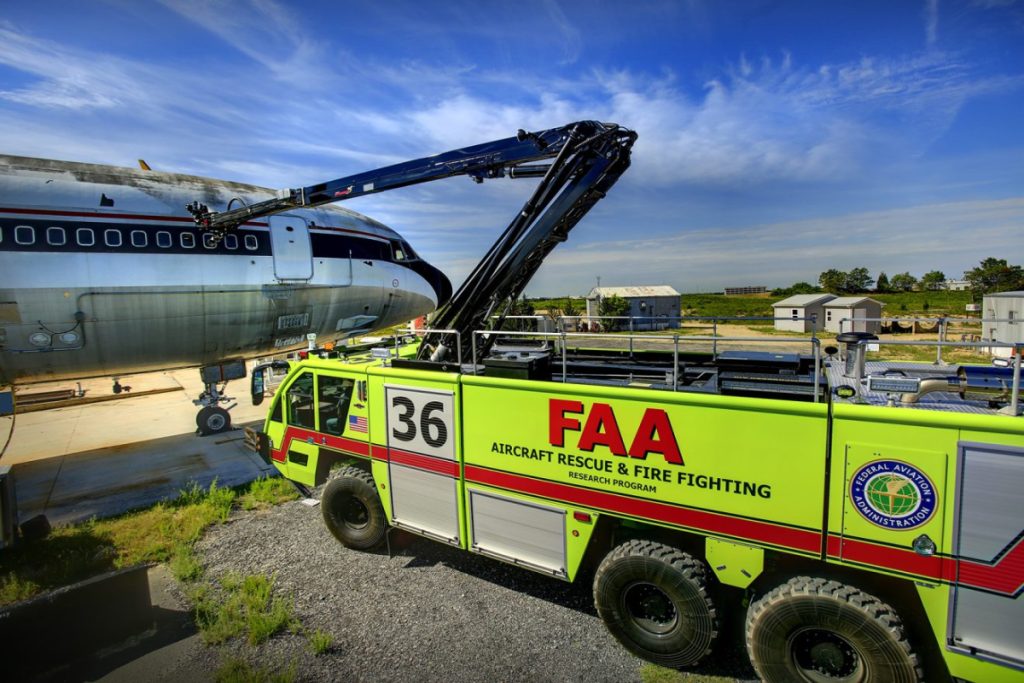
For the last two years, that has meant taking a deep dive—not literally—into fluorinated aqueous film-forming foam (AFFF). More specifically, he’s been trying to find an AFFF replacement because as currently designed, the fire-suppressing material contains per-and polyfluoroalkyl substances (PFAS), “forever chemicals” that can seep into soil and water tables.
The challenge, and it is substantial, is that those very same chemicals are the “magic” in how the foam works.
Bagot has reviewed literature, studied what foams are out there now, evaluated what levels of certification they have and is testing them at the center’s $5 million indoor fire test facility that opened in January 2020. This process will likely conclude with a new test standard because any foam lacking PFAS chemicals is not as effective as those with them.
“We don’t take it from the dream and the idea,” Bagot says. “We work with manufacturers to get it right, then get it into our standards.”
In December 2021, Bagot was awarded the Engineer/Scientist of the Year Award from the Southern New Jersey Professional Societies, recognizing his decades of service and contributions to the Aircraft Rescue and Fire Fighting (ARFF) research program. It’s an award he earned in ways large and small.
When he began working for ARFF, he opted to go through training as an airport firefighter so he could better understand what was going on and better communicate with other firefighters. That’s why he can tell you that it takes 90 seconds for flames to burn through most common airframes and enter the airplane itself, which is why airport emergency response must be flawless in its operations.
Bagot’s training also helped him lead an effort to modify a key component of an FAA fire truck: the high-reach extendable turret. Developed in the 1990s, this tool was refined, under Bagot’s guidance and working with manufacturers, to ensure it can work with all types of aircraft, no matter their size.
“Now, most any airport that serves those type of aircraft will have those,” Bagot says.
The fourth Panther at ATR works in a division that literally represents the foundation of airports: pavement. Flynn is project manager there, and his domain is the 12,000-square-foot National Airport Pavement Test Facility, where he manages the construction, reconstruction and design of pavement test items.

Yes, that is as it sounds: They build 300-foot stretches of pavement in the facility and test them with a million-pound rig that simulates a full airplane.
“We build small sections of runway and test them to what we call ‘failure points’ to better understand construction requirements,” Flynn says. “Ultimately, the goal is to increase the life of the pavement and reduce overall initial costs.”
This isn’t your average highway, which tends to be 18- to 24-inches thick and capable of supporting tractor trailers weighing as much as 80,000 pounds. Runways are generally 3- to 5-feet thick to support aircraft that weigh 800,000 pounds or more—with the biggest, such as the A380, hitting 1.2 million pounds.
Flynn was a field engineer for the Army Corps of Engineers when it was tasked with building the pavement test facility, so his knowledge of that domain is almost intrinsic. Within six months of the completed project, the FAA had offered him a job. That was in 2000.
One of the breakthroughs he helped bring about involved the intersection of his lab research and sensor installation at working airport runways.
In 2006, Flynn and his team instrumented a section of pavement at Hartsfield-Jackson Atlanta International Airport. In installing the sensors, they developed techniques—since repeated at other airports—for undertaking field installations that ensure sensors survive different types of construction.
Pavement or fire foam, obstruction lights or drones—no matter the material, area or use, the similarity is clear: innovation.
“It’s really cool to be that pioneer,” DiPilato says.
This piece was featured in the spring 2022 edition of Florida Tech Magazine.


